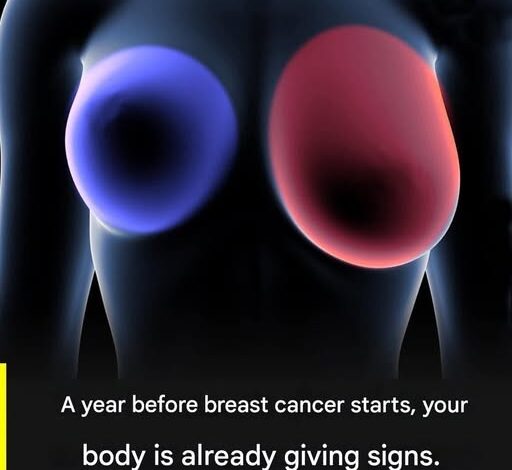Breast cancer remains one of the most serious health threats women face, and while medical advances have improved survival rates dramatically, early detection is still the strongest defense. The body often whispers before it screams, offering subtle warnings long before a diagnosis. Recognizing these early signs can make the difference between catching cancer at a highly treatable stage and discovering it too late. Every woman deserves to know what to look for, trust her instincts, and take action without hesitation.
One of the most overlooked symptoms is a change in the skin’s appearance—specifically when the breast begins to show a texture similar to an orange peel. This isn’t just mild irritation or a temporary rash. It’s a tightening, dimpled, or uneven look that signals something happening beneath the surface. The skin may appear thicker, slightly swollen, or more rigid than usual, sometimes accompanied by redness or warmth. These changes can be connected to inflammatory processes in the tissue and should never be dismissed as a simple cosmetic issue. When the skin starts to shift in this way, it’s your body telling you something is wrong. A specialist should take a look immediately to determine whether there’s an underlying condition that needs treatment.
Changes in the nipple can also be early red flags, and they’re often easier to overlook because many women assume nipples naturally shift or behave unpredictably. But sudden changes—like the nipple retracting inward, pointing in a different direction, or taking on an unusual shape—can indicate structural changes inside the breast. Discharge is another sign that requires urgent medical attention. Fluid that is milky, yellowish, or clear may not be cause for alarm, but discharge containing blood or appearing spontaneously without squeezing is a firmly established warning sign. Any change in the nipple’s appearance or behavior deserves a professional evaluation, even if it seems minor.
Another area that demands attention is the armpit. The lymph nodes located there act as filters for the body, trapping and destroying harmful substances. When they swell, it can mean the body is fighting an infection. But when a lump in the armpit appears without any cold, fever, or illness—and especially when it persists—this may indicate that abnormal cells are present. Many women don’t routinely check their armpits when examining their breasts, but they should. Lymph nodes located high in the armpit or along the collarbone can be involved early in the development of breast cancer. If you notice swelling, tenderness, firmness, or a lump in that region, it’s time to seek medical guidance. Only proper imaging and clinical evaluation can determine what is happening under the surface.
These signs may sound alarming, but knowledge is power. One of the simplest ways to protect yourself is through consistent self-checks. Doctors recommend doing a breast self-exam once a month, ideally a few days after menstruation ends, when breast tissue is less sensitive and swelling has gone down. The goal isn’t to diagnose yourself—it’s to learn what “normal” feels like for your body. That way, when something changes, you notice it right away. Many women don’t find their first sign of cancer through pain; they find it through awareness.
As women age, especially after forty, mammograms become essential. Screening schedules vary depending on personal and family history, but most doctors recommend a mammogram every one to two years. These screenings can detect tumors long before they are large enough to be felt. Early detection can dramatically increase the chances of successful treatment, often allowing for more options and less aggressive interventions. Modern mammography is fast, precise, and widely available, and for many women, it has been the tool that caught cancer at the earliest, most treatable stage.
It’s also important to remember that breast cancer doesn’t always present with obvious symptoms. Some women feel perfectly healthy and still discover an abnormality during a routine exam. This is why screening, awareness, and paying attention to your body’s signals matter just as much as making doctor’s appointments. When it comes to breast cancer, ignoring something unusual is never worth the risk.
If you notice any change—big or small—don’t wait and hope it passes. A shift in skin texture, a nipple that suddenly behaves differently, a lump under your arm, or any new discomfort should be checked as soon as possible. You’re not being dramatic. You’re advocating for your health. One appointment could save your life.
Breast cancer doesn’t discriminate. It affects young women, older women, women with a family history, and those with none. The strongest protection you have is awareness, consistency, and courage. Paying attention to your body isn’t fear—it’s responsibility. It’s strength. It’s survival.
Taking care of yourself is not optional. It’s the foundation for everything else in life. Your future depends on the choices you make right now: to stay informed, to trust your instincts, and to seek help the moment something feels off.
Your health is worth the effort. Prevention is worth the time. And your life is worth every bit of vigilance.
